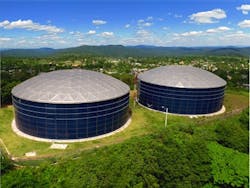Coating Processes Protect Tanks Against Corrosion
Today’s water and wastewater storage tanks are built for durability. However, a tank’s durability and total lifecycle often are dependent on the influence of its primary adversary: corrosion. The one thing standing between a storage tank and damaging corrosion is the tank’s most valuable feature: its coating.
A storage tank’s coating impacts several other features, including cost, total lifecycle, ease of construction and maintenance. Many technologically advanced coatings of glass or epoxy are utilized in tank construction. But not all coatings are equal. The type of coating, as well as the application process, is what separates the quality of one water and wastewater storage tank from another.
Factory-applied coatings may be thermally cured either in temperature-controlled ovens or by ambient air, in the case of epoxy coating systems. Porcelain enamel tanks (glass-fused-to-steel) made with glass frit cannot be fused to a substrate in the field; therefore, glass-fused-to-steel coatings are only factory-applied. Fusing glass to steel requires molecular interaction, which results in a premium coating that blends glass and steel to a hard inert barrier, so one cannot be separated from the other. Other technologies currently available with glass-fused-to-steel processes are glass-edge coating and TiO2 technology. Improved processes for glass-fused-to-steel tanks allow for optimum glass encapsulation on all four sides of the sheet edges, ensuring complete coverage of each sheet where corrosion usually starts: the edges. White interiors of tough TiO2 glass formulations are also available for a more durable product, with the added benefit of being easier to inspect than other colors.
A tank is only as strong as its coating. The better the coating application process, the longer the tank will last. Ask for data and case histories about how the coating performed over time. Finally, investigate quality control and testing measures used throughout the process.
